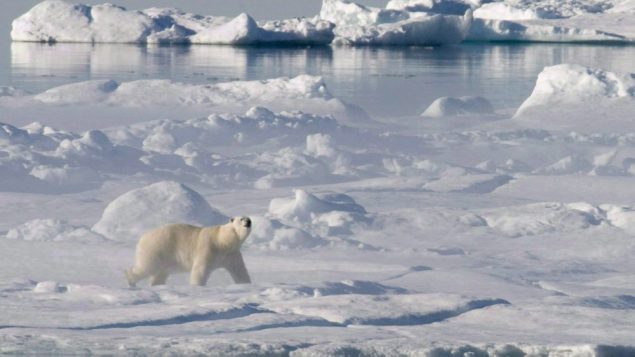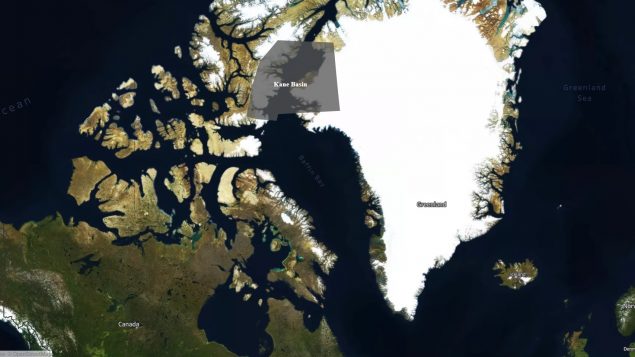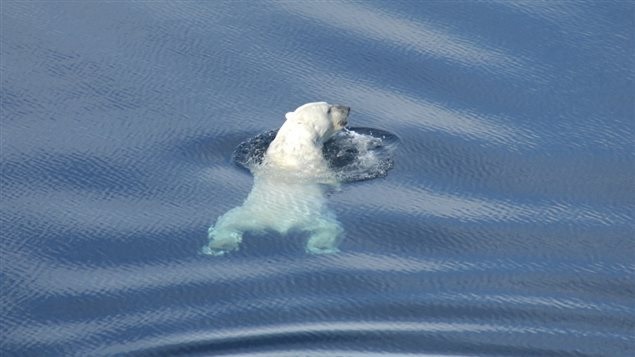As climate change threatens the survival of several polar bear populations in the lower Arctic latitudes, thinning sea ice in a region of the High Arctic between Canada and Greenland has been a boon for a small subpopulation of bears, according to a new study.
The research paper published on Sept. 23 in Global Change Biology looked at a population of roughly 300 to 350 bears in Kane Basin, a frigid channel between Canada’s Ellesmere Island and northwestern Greenland that used to be covered by thick, multiyear ice.
The research shows that Kane Basin polar bears, who make up about 1 to 2 per cent of the world’s polar bear population, are doing better in recent years than they were in the 1990s.
The study finds the bears, on average, are healthier as conditions are warming. Researchers theorize that thinning and shrinking multiyear sea ice is allowing more sunlight to reach the ocean surface, which makes the system more ecologically productive.
“We find that a small number of the world’s polar bears that live in multiyear ice regions are temporarily benefiting from climate change,” said in a statement lead author Kristin Laidre, a polar scientist at the University of Washington Applied Physics Laboratory’s Polar Science Center.
‘The duration of these benefits is unknown’

A polar bear stands on a ice flow in Baffin Bay above the arctic circle as seen from the Canadian Coast Guard icebreaker Louis S. St-Laurent on July 10, 2008. (Jonathan Hayward / The Canadian Press)
However, if emissions of greenhouse gases continue unabated and the climate keeps warming, within decades these polar bears will likely face the same fate as their southern cousins, who are already suffering from declining sea ice, researchers warn.
“The duration of these benefits is unknown. Under unmitigated climate change, we expect the Kane Basin bears to run into the same situation as polar bears in the south — it’s just going to happen later,” Laidre said.
University of Alberta polar bear biologist Andrew Derocher said the population in Kane Basin is one of the most northern of the 19 populations across the Arctic.
“This is an area where analyses have predicted that polar bears will persist for the longest and at least to the end of this century,” Derocher told Radio Canada International.

Kane Basin is marked by the grey shaded area (Courtesy of University of Washington)
This area, however, during colder periods was not a particularly good habitat, he added.
“There have never been very many bears there,” Derocher said. “With some warming, the population of bears has done better because the ice conditions have improved – there is less thick multiyear ice and more annual ice.”
Annual ice is the preferred habitat of ringed seals and bearded seals that are the primary prey of polar bears, said.
“As the title of the paper notes, we believe these are likely ‘transient benefits,’” Derocher said.
‘A sweet spot’
This sort of shift has been noted for other Arctic species that may see a period – many decades even – before the conditions deteriorate, he added.
“There is a ‘sweet spot’ for polar bears and sea ice: not too much and not too little,” Derocher said. “As this study shows, the ecosystem has shifted somewhat toward being just right.”
Continued sea ice loss will eventually pose a challenge for the Kane Basin population, he said.
“It’s important not to jump to conclusions and suggest that the High Arctic, which historically was covered by multiyear sea ice, is going to turn into a haven for polar bears,” said Laidre.
“The Arctic Ocean around the North Pole is basically an abyss, with very deep waters that will never be as productive as the shallower waters to the south where most polar bears live.”
A shorter on-ice hunting season

A polar bear swims in the Beaufort Sea looking for ice near Tuktoyaktuk, N.W.T., Canada April 27, 2009. (Andrew Derocher/University of Alberta)
All of the world’s 19 polar bear subpopulations, including Kane Basin, are experiencing a shorter on-ice hunting season, according to a 2016 study led by Laidre.
This makes it hard for polar bears, whose primary prey is seals, to meet their nutritional needs. Polar bears venture out on sea ice to catch seals. In summer when the sea ice melts, the polar bears fast on land. Sometimes they snack on birds’ eggs but the nutritional value of this food is not nearly enough to replace seal meat and blubber.
“The increasing summer ice conditions changing from 109 to 160 days over such a short period is quite a concern,” Derocher said. “If this period increases to about 180-220 days, we can expect to see a reduction in survival and reproductive rates.”
Derocher said another study that included Laidre showed that sea ice in this area is decreasing in duration of cover by 18 to 24 days per decade.
“This is not the fastest rate, the fastest is in the Norwegian and Russian Arctic in the Barents Sea at over 30 days per decade,” Derocher said. “Nonetheless, losing ice at this rate is a significant conservation challenge going forward.”
There is also concern that a very bad year in any polar bear population could have devastating effects, causing the population to drop by as much as a half in a single year, he added.
“It would only take a particularly early melt and a particularly late freeze-up to cause a population collapse,” Derocher said.
Another concern is that researchers don’t have many insights on the polar bear situation in the Laptev Sea, in the Russian Arctic, which saw record low levels of sea ice this year, Derocher said.
“The bears in this area have been thought to have been fairly removed from the effects of climate change so far but 2020 was an off the chart bad year there due to the warming in Siberia,” Derocher said. “Unfortunately, there is no monitoring of polar bears there.”







For reasons beyond our control, and for an undetermined period of time, our comment section is now closed. However, our social networks remain open to your contributions.